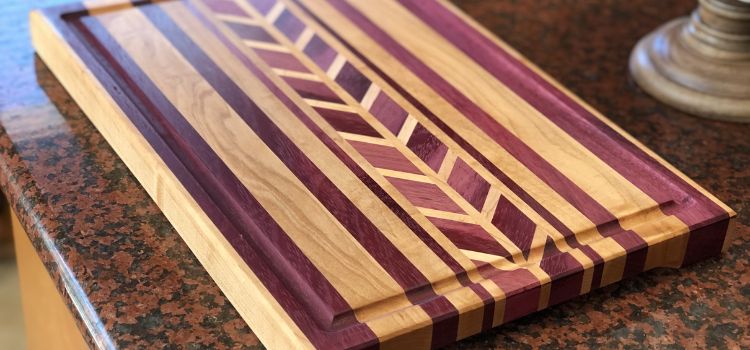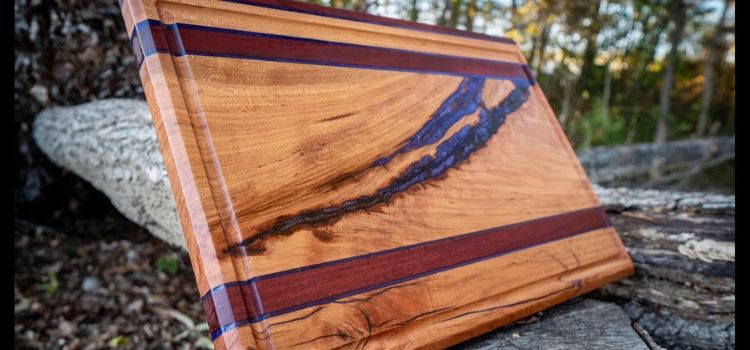As an Amazon Associate, I earn from qualifying purchases

Purple heart wood isn’t just named for its distinctive color; it’s a wood that stands out in any setting. Originating from Central and South America, it’s prized in woodworking for its unique hue, which can range from a rich violet to a deep purple.
As it ages, this wood often darkens, adding a sense of timeless elegance to any project. While commonly used in fine furniture, flooring, and decorative woodwork, its application in cutting boards is a subject of particular interest for both professional chefs and home cooks.
Properties of Purple Heart Wood
Understanding the properties of purple heart wood is crucial when assessing its suitability for cutting boards.
- Physical Properties: Purple heart is a dense and heavy hardwood, known for its durability. Its hardness makes it resistant to wear and tear, a desirable trait for a surface that will see frequent knife action. The grain is typically straight, though it can occasionally be wavy, providing a unique texture that enhances its aesthetic appeal.
- Workability and Resistance to Wear: Despite its beauty, purple heart can be challenging to work with due to its hardness. However, once shaped and finished, it offers excellent resistance to scratches and dents. This resilience makes it a solid candidate for enduring the daily rigors of chopping, slicing, and dicing.
Advantages of Purple Heart Cutting Boards
Choosing purple heart for cutting boards comes with several notable advantages.
- Unique Aesthetic Appeal and Vibrant Color: The most immediate advantage is its stunning color. A purple heart cutting board can serve as a striking focal point in any kitchen, blending functionality with artistry. Its vibrant hue is unlike any other wood, making it a conversation starter.
- Durability and Resistance to Scratches: The hardness of purple heart means it’s less likely to scratch compared to softer woods. This durability translates to a longer lifespan, allowing the board to maintain its integrity and appearance over time.
- Natural Resistance to Moisture and Pests: Purple heart wood has a natural resistance to moisture, which helps prevent warping—a common problem with wooden cutting boards. Additionally, it’s resistant to pests, reducing the risk of infestations that can compromise the wood’s structure.
Disadvantages of Purple Heart Cutting Boards
Despite its many advantages, there are some downsides to consider.
- Potential for Color Fading Over Time: While the initial color is a major draw, purple heart’s vibrant hue can fade with prolonged exposure to sunlight and air. This natural change may disappoint those who wish to retain the wood’s original vibrancy.
- Heavier Weight Compared to Other Woods: The density that contributes to its durability also makes it considerably heavier than other woods. For some, this increased weight can make handling and cleaning the board more cumbersome.
- Cost Considerations: Purple heart is generally more expensive than traditional cutting board woods like maple or walnut. For budget-conscious buyers, this premium cost may be a deciding factor.
Comparison with Other Cutting Board Materials
To fully appreciate purple heart’s place in the realm of cutting boards, comparisons with other materials are essential.
- Purple Heart vs. Traditional Hardwoods: Compared to traditional hardwoods such as maple and walnut, purple heart offers superior hardness and scratch resistance. However, its tendency to dull knives faster and its higher cost may sway some users toward more conventional choices.
- Purple Heart vs. Synthetic Materials: Synthetic materials like plastic and composite offer advantages in terms of weight and price, but they lack the natural beauty and durability of purple heart. While they are easier to clean and maintain, they can’t match the aesthetic appeal and environmental benefits of a wooden board.
Factors to Consider When Choosing Purple Heart for Cutting Boards

When selecting purple heart for cutting boards, several factors should be kept in mind.
Durability and Long-term Use
While purple heart’s durability is a major advantage, its hardness can be tough on knives. Regular sharpening may be necessary to maintain blade performance.
Maintenance Requirements
Maintaining a purple heart cutting board involves routine oiling to preserve its moisture resistance and protect against warping. Careful cleaning with mild soap and water, followed by immediate drying, is also recommended.
Availability and Cost
The availability of purple heart can vary depending on location, impacting its price and accessibility. Buyers should consider these factors when weighing their options.
Practical Advice for Consideration
For those leaning toward purple heart, here are some practical tips:
Care and Maintenance Tips
To extend the life of your purple heart cutting board, avoid prolonged exposure to direct sunlight, which can accelerate color fading. Regularly apply food-grade mineral oil to maintain its luster and moisture resistance.
Best Uses in the Kitchen
Due to its hardness, purple heart is best suited for tasks that don’t require heavy chopping, such as cutting vegetables or serving cheeses. For heavy-duty tasks, a softer wood or a separate board may be preferable to preserve knife sharpness.
Conclusion
In conclusion, purple heart wood offers a unique blend of beauty and durability, making it an intriguing choice for cutting boards. Its vibrant color and resistance to wear make it a standout option, though potential buyers should consider its cost, weight, and maintenance needs.
Ultimately, purple heart can elevate the aesthetic and functionality of a kitchen, provided it aligns with the user’s preferences and lifestyle. By weighing these factors, you can make an informed decision that balances practicality with style, ensuring your cutting board is both a functional tool and a beautiful addition to your home.
FAQ
What are the disadvantages of purple heart wood?
Purple heart wood can be challenging to work with due to its hardness, which may dull knives faster. It is also heavier than other woods, which can be cumbersome during use. Additionally, its vibrant color may fade over time with exposure to sunlight and air, affecting its aesthetic appeal.
Is purple heart wood safe?
Yes, purple heart wood is generally considered safe for use, including in cutting boards. It is naturally resistant to moisture and pests, which helps prevent contamination. However, as with all woods, it should be properly sealed and maintained to prevent potential health risks from bacteria and mold.
What is the best color for a cutting board?
The best color for a cutting board largely depends on personal preference and kitchen aesthetics. Neutral tones like those of maple and walnut are popular for their classic look and ability to hide stains. Bright colors, like purple heart wood, can create a striking visual impact, adding vibrancy to kitchen decor.
As an Amazon Associate, I earn from qualifying purchases